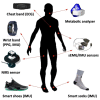Monitoring Resistance Training in Real Time with Wearable Technology: Current Applications and Future Directions
- PMID: 37760187
- PMCID: PMC10525173
- DOI: 10.3390/bioengineering10091085
Monitoring Resistance Training in Real Time with Wearable Technology: Current Applications and Future Directions
Abstract
Resistance training is an exercise modality that involves using weights or resistance to strengthen and tone muscles. It has become popular in recent years, with numerous people including it in their fitness routines to ameliorate their strength, muscle mass, and overall health. Still, resistance training can be complex, requiring careful planning and execution to avoid injury and achieve satisfactory results. Wearable technology has emerged as a promising tool for resistance training, as it allows monitoring and adjusting training programs in real time. Several wearable devices are currently available, such as smart watches, fitness trackers, and other sensors that can yield detailed physiological and biomechanical information. In resistance training research, this information can be used to assess the effectiveness of training programs and identify areas for improvement. Wearable technology has the potential to revolutionize resistance training research, providing new insights and opportunities for developing optimized training programs. This review examines the types of wearables commonly used in resistance training research, their applications in monitoring and optimizing training programs, and the potential limitations and challenges associated with their use. Finally, it discusses future research directions, including the development of advanced wearable technologies and the integration of artificial intelligence in resistance training research.
Keywords: cardiac activity; exercise physiology; movement; muscle activity; performance; sport; telemonitoring; training.
Conflict of interest statement
The authors declare that the research was conducted in the absence of any commercial or financial relationships that could be construed as potential conflict of interest.
Figures






Similar articles
-
Application of artificial intelligence in wearable devices: Opportunities and challenges.Comput Methods Programs Biomed. 2022 Jan;213:106541. doi: 10.1016/j.cmpb.2021.106541. Epub 2021 Nov 17. Comput Methods Programs Biomed. 2022. PMID: 34837860 Review.
-
The Impact of AI on the Development of Multimodal Wearable Devices in Musculoskeletal Medicine.HSS J. 2025 Jun 11:15563316251344945. doi: 10.1177/15563316251344945. Online ahead of print. HSS J. 2025. PMID: 40520850 Free PMC article. Review.
-
Commentary: Is Wearable Fitness Technology a Medically Approved Device? Yes and No.Int J Environ Res Public Health. 2023 Jun 27;20(13):6230. doi: 10.3390/ijerph20136230. Int J Environ Res Public Health. 2023. PMID: 37444078 Free PMC article.
-
StayFit: a wearable application for Gym based power training.Annu Int Conf IEEE Eng Med Biol Soc. 2016 Aug;2016:6290-6293. doi: 10.1109/EMBC.2016.7592166. Annu Int Conf IEEE Eng Med Biol Soc. 2016. PMID: 28269687
-
A Wearable-Sensor System with AI Technology for Real-Time Biomechanical Feedback Training in Hammer Throw.Sensors (Basel). 2022 Dec 30;23(1):425. doi: 10.3390/s23010425. Sensors (Basel). 2022. PMID: 36617025 Free PMC article.
Cited by
-
The Role of Physical Activity in Adjunctive Nursing Management of Neuro-Degenerative Diseases among Older Adults: A Systematic Review of Interventional Studies.Life (Basel). 2024 May 7;14(5):597. doi: 10.3390/life14050597. Life (Basel). 2024. PMID: 38792618 Free PMC article. Review.
-
The Role of Physical Activity and Exercise in Enhancing Resilience and Delaying Frailty in Saudi Arabia.Healthcare (Basel). 2025 Jun 18;13(12):1461. doi: 10.3390/healthcare13121461. Healthcare (Basel). 2025. PMID: 40565490 Free PMC article.
-
Hypoxia matters: comparison of external and internal training load markers during an 8-week resistance training program in normoxia, normobaric hypoxia and hypobaric hypoxia.Eur J Appl Physiol. 2024 Aug;124(8):2273-2283. doi: 10.1007/s00421-024-05442-1. Epub 2024 Mar 6. Eur J Appl Physiol. 2024. PMID: 38446192 Free PMC article.
-
Heart Rate Variability and Autonomic Dysfunction After Stroke: Prognostic Markers for Recovery.Biomedicines. 2025 Jul 7;13(7):1659. doi: 10.3390/biomedicines13071659. Biomedicines. 2025. PMID: 40722730 Free PMC article. Review.
-
Advanced biomechanical analytics: Wearable technologies for precision health monitoring in sports performance.Digit Health. 2024 May 27;10:20552076241256745. doi: 10.1177/20552076241256745. eCollection 2024 Jan-Dec. Digit Health. 2024. PMID: 38840658 Free PMC article.
References
-
- Carvalho L., Junior R.M., Barreira J., Schoenfeld B.J., Orazem J., Barroso R. Muscle Hypertrophy and Strength Gains after Resistance Training with Different Volume-Matched Loads: A Systematic Review and Meta-Analysis. Appl. Physiol. Nutr. Metab. 2022;47:357–368. doi: 10.1139/apnm-2021-0515. - DOI - PubMed
Publication types
Grants and funding
LinkOut - more resources
Full Text Sources

